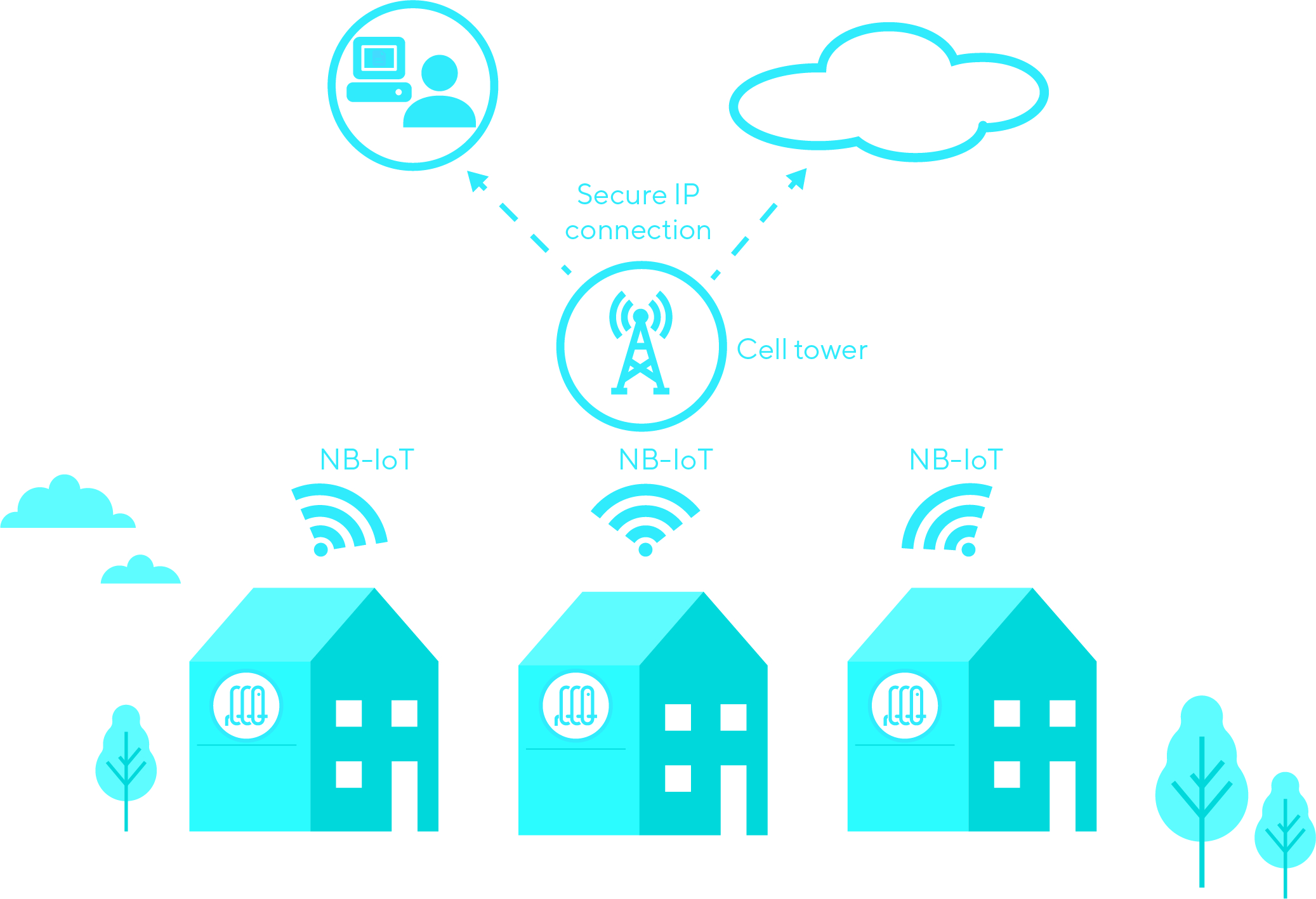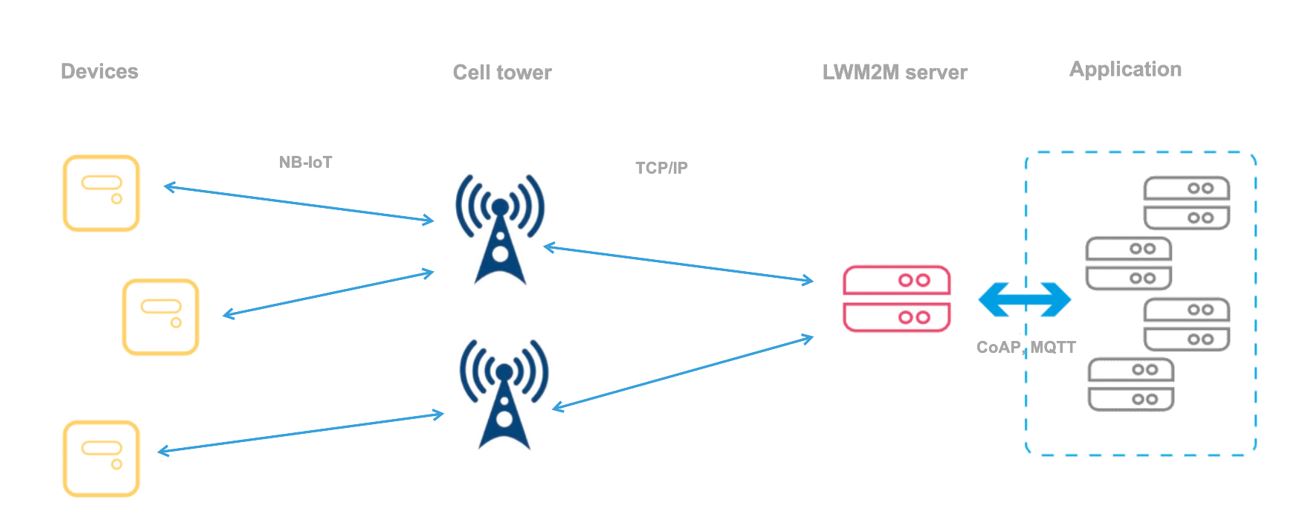NB-IoT
NB-IoT is a standard radio technology that operates in the licensed frequency band and is designed to provide an optimal combination of range and energy efficiency.
The Internet of Things (IoT), which connects different types of devices with overarching systems, requires powerful and reliable communication technologies. NB-IoT was developed specifically for applications in the Internet of Things to meet the requirements of ubiquitous networking.
NB-IoT – the most important thing about the emerging technology
The abbreviation NB-IoT stands for Narrowband-IoT and is a connectivity technology for narrowband transmissions with small amounts of data, which was developed specifically for the IoT network. The most important characteristics of the special IoT technology are the following:
- NB-IoT uses the existing LTE mobile infrastructure and is characterized by a long battery life of the connected devices.
- High transmission security and reliability, high network coverage and penetration capability, and a low energy consumption rate are the advantages of NB-IoT.
- NB-IoT is used in a wide range of applications, including smart metering, smart cities, asset tracking, building automation and more.
- Since it is a standard protocol that is compatible with different networks and devices, regardless of manufacturer, NB-IoT is efficiently scalable.
- NB-IoT also provides a high level of data security through encryption and authentication of data transmission.


Standard and compatibility
NB-IoT refers to a category of standards developed by 3GPP, an umbrella organization working with standardization for mobile telecommunication networks. NB-IoT was fist standardised in 3GPP Release 13 as “LTE category NB1”, later updated with NB2 in Release 14. The standard basically covers how an NB-IoT device shall function and communicate in a telecommunications network and the different mechanisms available for saving power (battery). The latter is a very important part, but the power saving functions are not mandatory, so the device’s actual battery performance ultimately depends on what functions the network provider currently supports. Guidelines are developed to make this as homogenous as possible between different telecom providers.
The standard covers all communication layers up to the transport layer. This means that an NB-IoT device is essentially like a computer connected to the internet. While this facilitates for a wide range of different protocols that can be used, it also allows for a high dissimilarity between how different NB-IoT devices are operated and how metering data is encoded.
Technical performance
NB-IoT has often been put into head to head competition with LoRaWAN for the title of “best IoT radio technology”. Rather than choosing a winner this might be more of a choice of which eco-system to invest in and how the infrastructure should be managed. NB-IoT is managed by telecom operators, giving you defined service level but reliant on their geographical coverage. For LoRaWAN there are service providers, just like telecom operators, but you could also choose to build your own network infrastructure and expanding a LoRaWAN network is relatively inexpensive.
As with all telecommunication radio technologies NB-IoT performance is dependent on the overall quality and capacity of the service provider and damping of the signal caused by physical objects between sender and receiver. Compared to other radio solutions, NB-IoT offers high penetration (ability to pass through physical objects) which makes it suitable for deep indoor placement.
NB-IoT delivers a comparably (LPWAN) high bandwidth and capable downlink (server to device) capacity. This enables more data demanding applications, over the air updates and flexible schemes for retrieving data (such as queries for missing data, historical data sets and verbose log information). This capacity in combination with being a technology adapted to complex telecommunication networks, comes with the cost of being more power hungry and having a less predictable power consumption over time. Albeit this, constrained battery operation for well above 10 years is achievable with reasonably sized battery cells.
Suitable applications
For customers that wishes to use telecom operators for their infrastructure, NB-IoT is ideal for more demanding sensor and metering applications. Both being at a lower cost point compared to other mobile telecommunication solutions and offering an energy efficient solution for battery operated devices. It is important to also include the network provider in the equation when looking at suitableness to assure that service level is adequate, especially in more rural areas.
Cost-saving and energy-efficient – the advantages of NB-IoT at a glance
As a network technology for the Internet of Things, NB-IoT brings along numerous decisive advantages. The NB-IoT connectivity modules, which communicate wirelessly, are equipped with energy-saving functions such as a sleep mode. In this way, maximum energy efficiency is achieved. In addition, NB-IoT has a particularly high power density thanks to the narrowband modulation methods. This is 5 decibels higher compared to LTE-M and even 20 decibels higher compared to GSM. In this way, optimal network coverage in the form of deep building penetration can be realized. This is particularly advantageous in remote areas, but also in buildings with basements whose measuring points are not equipped with 2G (GPRS) or 4G (LTE).
The installation of the NB-IoT infrastructure is also done in a simple way, as it works according to the plug-and-play principle. Sensors automatically connect to the NB-IoT network without the need to install local networks or additional gateways.
Since NB-IoT technology is suitable for power operation with 230V or a classic battery, it covers numerous of application. Last but not least, NB-IoT technology impresses with low acquisition, operating and service costs thanks to its simple chipset design.
For customers who want to use mobile network operators for their infrastructure, NB-IoT is ideally suited for demanding sensing and measurement applications. Compared to other mobile network solutions, the implementation of NB-IoT is more cost-effective and provides an energy-efficient solution for battery-powered devices.
Expert tip:
It is important to also involve the network operator in the suitability assessment to ensure that the level of service is adequate. This is especially true for applications in rural areas.
Realize secure data transmission with NB-IoT
NB-IoT not only offers high data transmission speed and long range, but also a high level of data security. The security of NB-IoT is ensured by encryption and authentication of data transmission. The encrypted data can only be decrypted by authorized recipients. Authentication of data transmission ensures that the transmitted data comes from a trusted source and has not been tampered with by an unauthorized person. These high security standards make NB-IoT an ideal technology for applications where security and privacy are of paramount importance, such as in the healthcare industry or safety-critical infrastructures.
As a standardized technology, NB-IoT fulfils the security mechanisms according to 3GPP and thus also has security functions that are constantly being reviewed and improved. NB-IoT devices can be updated remotely using Firmware over the Air (FOTA) to stay up to date with the latest technology.
LoRaWAN or NB-IoT? – the technical performance in comparison
NB-IoT is often put in a head-to-head race with LoRaWAN for the title of best IoT wireless technology. It's not so much about choosing a winner as it is about the question of which system to invest in which use case. NB-IoT is managed by mobile network operators who provide you with a certain level of service but are dependent on their geographical coverage. For LoRaWAN, as with mobile network operators there are service providers. It is also possible to build your own network infrastructure and expand the LoRaWAN network cost-effectively. As with all mobile network radio technologies, the performance of NB-IoT depends on the overall quality and capacity of the service provider and the attenuation of the signal by physical objects between the transmitter and receiver, with the technology providing high penetration compared to other wireless solutions.
NB-IoT offers comparatively high bandwidth (LPWAN) and powerful server-to-device downlink capacity. This enables more data-intensive applications, over-the-air updates, and flexible schemes for retrieving data, such as querying missing data, historical records, and detailed log information. This capacity, and the fact that it is a technology adapted to complex mobile networks, has the disadvantage of consuming more electricity and making electricity consumption less predictable over time. Nevertheless, limited battery operation of well over 10 years is possible with reasonably sized battery cells.
From smart metering to agriculture – applications of NB-IoT
NB-IoT is specifically designed for low-bandwidth, low-data rate applications. As a result, IoT technology has the potential to be used in a wide range of applications in particular:
- Smart cities, e.g. automated traffic monitoring
- Building automation
- smart farming
- Asset Tracking in Logistics
One of the key applications of NB-IoT is smart metering, a technology that allows utilities to monitor and control water, heat, gas and energy consumption in real-time. This form of automation significantly improves the energy efficiency of the building equipped with NB-IoT.
Meter Connectivity Modules (MCMs) are used to deliver data from meters, such as heating and cooling meters, to a receiving system via the NB-IoT network. Examples include the CMi6110 for the Landis+Gyr UH/UC50 (T550), the CMi6140 for Kamstrup Multical 403/603/803 and the CMi6160 for the SHARKY 755 and SCYLAR INT 8 models from Diehl Metering.
NB-IoT can also be used in smart cities to improve the quality of life of citizens. The technology can be used to control smart streetlights, implement automated traffic monitoring or also help monitor air quality and noise pollution in urban areas. Since NB-IoT has a long range and penetration capability the transmission protocol is ideally suited for use in rural, structurally weak and unstable environments. With NB-IoT, smart meter systems can be installed in remote areas, increasing energy efficiency and reducing dependence on fossil fuels.
NB-IoT standard and compatibility
As a standard protocol NB-IoT is developed with different devices and networks regardless of their manufacturer. NB-IoT and its associated standards were developed by 3GPP an umbrella organization dedicated to the standardization of mobile networks. NB-IoT was first standardized as LTE category NB1 in 3GPP Release 13 and later updated with NB2 in Release 14. The standard developed by 3GPP specifies how an NB-IoT device should function and communicate in a telecommunications network. The various mechanisms for saving energy in relation to batteries are also regulated.
The latter is a very important part; however, the energy-saving features are not mandatory. Rather, the actual battery power of the device depends on what features the grid currently supports. The standard develops guidelines to make this as consistent as possible between the various mobile network providers. Standardization covers all communication layers up to the transport layer. This means that an NB-IoT device essentially works like an internet-connected computer.
While this allows for a wide range of compatible protocols, it also means that the operation of the various NB-IoT devices and the coding of the measurement data are very different from each other. Nevertheless, NB-IoT systems can usually bescaled excellently because they have a high level of compatibility.
Elvaco – all NB-IoT devices in one place
Elvaco has a broad product portfolio around NB-IoT technology. From wall-mounted or magnetic antennas to transmit the signals to internal Meter Connectivity Module units, we carry a wide range of high-precision, energy-efficient and durable NB-IoT products. If you are interested in products from our comprehensive range, contact Elvaco's team of experts. We look forward to supporting you with our products and expertise in the implementation of your NB-IoT network.
FAQ – frequently asked questions about NB-IoT Technologies
What is NB-IoT?
NB-IoT stands for Narrowband IoT and is an LPWAN technology designed specifically for IoT applications. Unlike other IoT technologies such as Wi-Fi or Bluetooth Low Energy (BLE), NB-IoT operates on its own frequency band, which offers a longer range and better penetration capability.
What are the advantages of NB-IoT compared to other IoT technologies?
NB-IoT offers greater reach and better penetration capability than other IoT technologies. In addition, the devices used are battery-powered and have a lower data rate, resulting in longer battery life, making NB-IoT ideal for applications that require long-term monitoring. NB-IoT is also efficiently scalable and can manage a large number of devices on a network.
What applications do NB-IoT need?
NB-IoT is particularly well suited for applications where long battery life and long range are required. Examples include smart meters such as electricity, heat, water and gas meters, as well as asset tracking applications such as monitoring containers or pallets. NB-IoT can also be used in smart city applications, for example to monitor traffic or air quality.
How secure is NB-IoT?
NB-IoT uses the same security standards as cellular technology, including encrypting data and authenticating devices. In addition, the technology offers over-the-air (OTA) firmware updates to ensure that connected devices are always up to date.




 Subscribe to our newsletter
Subscribe to our newsletter